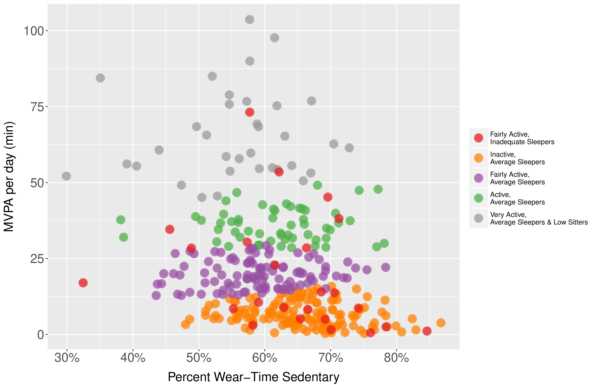Data from: Latent profile analysis of objectively measured sleep, physical activity, and sedentary time and associations with health in adult women
Data from: Latent profile analysis of objectively measured sleep, physical activity, and sedentary time and associations with health in adult women
About this collection
- Extent
-
1 digital object.
- Cite This Work
-
Full, Kelsie M.; Moran, Kevin; Carlson, Jordan; Godbole, Suneeta; Natarajan, Loki; Hipp, Aaron; Glanz, Karen; Mitchell, Jonathan; Laden, Francine; James, Peter; Kerr, Jacqueline (2018). Data from: Latent profile analysis of objectively measured sleep, physical activity, and sedentary time and associations with health in adult women. UC San Diego Library Digital Collections. https://doi.org/10.6075/J0HM56N6
- Description
-
Objectives: To identify latent rest-activity behavior profiles of objectively measured total sleep time, sleep efficiency, physical activity, and sedentary time in a diverse sample of U.S. women.
Methods: 372 women (mean age 55.4 + 10.2) were recruited from studies conducted across four US universities. Participants wore ActiGraph GT3X+ accelerometers on the hip and wrist for a week. Total daily minutes in moderate-to-vigorous physical activity (MVPA) and percentage of wear-time spent sedentary was estimated from the hip device. Total sleep time and sleep efficiency were estimated from the wrist device. Latent profile analyses were performed with these four rest-activity variables, and adjusted ANOVAs were conducted to compare behaviors, demographics, and health conditions across resulting behavior profiles.
Results: Participants achieved an average of 21.1 (SD=18.9) minutes of daily MVPA, and 62.1 (SD=8.7) percent of their daily time was spent sedentary. Mean nightly sleep time was 408.9 (SD=55.7) minutes, with an average sleep efficiency of 85.6 (7.5). These rest-activity variables clustered to form five behavior profiles including: 1) fairly active poor sleepers, 2) inactive average sleepers, 3) fairly active average sleepers, 4) active average sleepers, and 5) very active average sleepers & low sitters. Sleep was comparable across four of five behavior profiles (n=345, 92.5%). The behavior profile with the poorest sleep had the lowest proportion of whites (35% vs 78-91%, p < .001) and college graduates (28% vs 68-90%, p = .004). The largest profile (n=151, 40.6%) engaged in 7 min of MVPA per day. BMI and physical functioning varied across behavior profiles. Other health variables did not vary statistically, but trended in hypothesized directions.
Conclusions: Daily rest-activity behaviors do cluster in women to form distinct behavior profiles. These identified behavior profiles can inform population targeting or intervention goals of multiple health behavior interventions. - Date Collected
- 2012-10-10 to 2014-01-13
- Date Issued
- 2018
- Authors
- Co Principal Investigators
- Analyst
- Data Manager
- Note
-
Questions or comments regarding the data should be directed to Jacqueline Kerr (jkerr@ucsd.edu).
- Funding
-
This work was supported by: National Cancer Institute (http://www.cancer.gov/) Centers for Transdisciplinary Research on Energetics and Cancer grants U01 CA116850, U54 CA155496, U54 CA155626, U54 CA155435, U54 CA155850; National Institutes of Health (https://www.nih.gov/) grants UM1 CA176726 and R01 ES017017; Harvard National Heart Lung and Blood Institute (http://www.nhlbi.nih.gov/) Cardiovascular Epidemiology Training Grant T32 HL 098048 (PJ); National Cancer Institute (http://www.cancer.gov/) grant F32CA162847 (JM) and K99CA201542 (PJ). The funders had no role in study design, data collection and analysis, decision to publish, or preparation of the manuscript.
- Topics
Format
View formats within this collection
- Related Resource
- Full KM, Moran K, Carlson J, Godbole S, Natarajan L, Hipp A, et al. (2019) Latent profile analysis of accelerometer-measured sleep, physical activity, and sedentary time and differences in health characteristics in adult women. PLoS ONE 14(6): e0218595. https://doi.org/10.1371/journal.pone.0218595
Primary associated publication
 Library Digital Collections
Library Digital Collections
